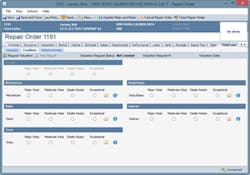At a recent industry meeting I was chatting with some other repairers about insurance Direct Repair Program (DRP) relationships. One of the people works for one of the big four consolidators. He said, “We are the company of ‘YES.’ Anything they (insurers) ask of us, the answer is always yes.”
As an industry we seem to be going in that direction. We continue to provide more and more administrative services for the insurers through our DRP commitments. Many insurers have been reducing staff as repairers increase staff to handle more. Self-managed programs are becoming more prevalent. Repairers are offering to do more, or at least agreeing to do more, and insurers appear to be happy to pass on responsibilities while obviously enjoying the cost savings. Receiving customer referrals from insurers is obviously one of the motives. Another consideration is the increasing insurer dependence upon repairers, thus bringing an increase in perceived stability. In other words, it’s less likely insurers would remove a repairer from a program on a whim when both parties know the insurer doesn’t have the staff to handle the claim handling responsibilities being provided by a large repairer.
Handling total loss administrative work for insurers is one of those services that has become common in recent years. Generally shops are providing the service for no charge, often as a required provision within DRP agreements. It can be very time consuming. Not only is there a cost of staff labor, but also an obligation to provide accuracy. In some cases, a resulting liability can come with expense as well. I’ll discuss more on that later.
Total losses, industry trends
According to CCC Information Services, U.S. vehicle population has begun to grow again, and more miles are being driven with the greatest growth on interstates where accidents occur at higher speeds. Whether or not this is helping to drive up repair costs, increasing vehicle complexity alone certainly is. With a ‘hangover’ of an older fleet still on the road in the U.S. driving up total loss frequency, the industry is the unfortunate recipient of a market where frequency has returned to pre-recession levels, and costs are rising for both repairs and increased volume of total losses.
Don Mikrut, VP MSO Operations, AudaExplore, provided the following information:
Total Loss vs. Repair
Volume Changes Industry
o Collision claims frequency increased 5.92 claims per 100 earned car years.
o In 2014, there were over 401,000 more collision claims vs. 2013.
Source of data from CollisionWeek & ISS
Volume Changes Total Loss from Insight
o Total Loss evaluations increased 16% in 2014 vs. 2013
o Total Loss evaluations projected to increase in 2015 is 8%
· We predict that the volume of Total Loss claims will increase 8% in 2015 over what it was in 2014, while Total Loss Claims increased 16% in 2014 over 2013.
It could be a total lossI
n most cases, a vehicle that is hit hard enough to become a total loss is towed in. In a DRP scenario typically the shop receives an electronic assignment and starts the claims handling process by getting the vehicle delivered from a tow lot to the shop. In many cases there is a time requirement, such as a required maximum of 48 hours to get the vehicle delivered and to upload an estimate. Obviously, the insurer wants to minimize the storage fees. I’ve seen examples of shops being slow in terms of starting the claims handling process and getting the car moved, resulting in the insurer expecting the shop to cover some storage fees. The estimate process is started. The estimator may elect to have the vehicle partially torn down to identify unseen damage. However, they must be cautious, as some insurers are reluctant to authorize payment for more than a couple hours of labor without prior authorization. They must also keep in mind that if the vehicle becomes a total loss the insurer may require that the vehicle be reassembled to maximize any salvage sale opportunity. Yet there is an expectation that the estimate be thorough and cost effective, including consideration of alternative parts (typically salvage parts, aftermarket parts, or remanufactured parts). Throughout this process there is also a required communication with insurer and consumer. The estimator must follow specific insurer guidelines for reporting including notes regarding timing, parts considerations, anticipated unseen damage issues, and prior unrelated damage. Today’s estimators must be fast, very thorough, and very knowledgeable on specific guidelines that vary with each and every insurer. It’s a demanding job. To accomplish the tasks described so far it can easily take one or two hours or more of the estimator’s time.
Typically only the insurer will determine if the vehicle will in fact be considered a total loss. In these DRP scenarios it is the shop’s responsibility to provide the data and documentation that the insurer can use to make the decision and to substantiate not only the decision but the precise value as well. Today’s automated estimating systems have approximate vehicle replacement values built in and will show the user what the repair cost represents as a percentage of the replacement value. Once the cost hits a certain threshold estimators are typically required to communicate with insurers for instruction. In some DRP’s, the estimator is to proceed with starting the process to determine an accurate vehicle replacement cost. In some cases this is referred to as the Vehicle Inspection Review (VIR).
The process up to this point comes with the obligation for thoroughness and accuracy. It’s understood that the shop’s work in providing photos and an accurate competitive estimate could wind up being used in subrogation and potentially in a court of law. The total loss work comes with an additional level of responsibility. The documentation will be used to determine a fair replacement cost of the vehicle in the same geographic area at the time of the loss, sometimes referred to as Actual Cash Value (ACV). Often the value doesn’t match the customer’s hopes or expectations. Any inaccuracy or oversight can change the calculated value. One insurance staff person reported that settling total loss claims is among the least desirable jobs within the insurance company. Insurers expect thoroughness and precise accuracy. In fact, they may demand it. They may even expect a shop to assume some financial responsibility. I know of one reported case where the shop estimator/inspector incorrectly logged the vehicle mileage. It was an innocent mistake, but the estimator/inspector neglected to log the first “1,” indicating the vehicle had less than 100,000 miles when in fact it was over. The insurer settled the claim with the vehicle owner and later noticed the mistake. They determined that as a result they overpaid the vehicle owner by $2500. They came back to the shop and stated that they expected the shop offer partial restitution of $500. The shop complied. You can imagine how they felt. They made no markup on the tow, handled the estimating process for free, spent a lot of time on the vehicle total loss evaluation process for free, stored the vehicle until pick up for free, handled the billing and administration for free, then had to pay $500 for a simple mistake. Painful.
The documentation process
Even though the estimator took photos of the vehicle and damage according to the insurers expectations as part of the estimating process, there may be further photographic expectations. As part of the total loss evaluation process one major insurer wants a photo of every vehicle option. On a high end vehicle, that may necessitate as many as 50 to 100 photos. Another major insurer wants no more than 20 photos, yet still insists on adequate photographic evidence to support the vehicle and its condition. Obviously photographic quality is critical. Descriptive notes are also expected.
Next will be the task of documenting options and vehicle condition. Some insurers provide forms. Some of them come from information providers as part of their system. More on that later.
Some estimating systems can decode the Vehicle Identification Number (VIN) and provide options. It’s still prudent to check the vehicle for each option as the system may not be complete. Some systems require that the vehicle be inspected for each and every option. Aftermarket options are to be logged. Some of the provided forms use check boxes, including forms with over 150 boxes to be considered and logged accordingly. It’s not a simple task.
Condition, including wear and damage, are to be reported on all components including paint, trim, carpet, upholstery, headliner, wheels, and more. Tire wear is to be measured and logged. Mechanical condition is to be evaluated and logged, including leaks, exhaust, and notes for remanufactured engines or transmissions. Unrelated prior damage (UPD) is to be estimated for cost of repair and logged. One insurer asks that every panel ding be counted and logged.
Some forensic investigation may be required. For example, if the vehicle is damaged in a way that will prevent mileage from being obtained there may be oil change stickers on the windshield or in the door jamb that could be reported to give an idea of the current mileage. Some insurers will at times ask shops to reach out to the vehicle owner to obtain more information or documentation such as new vehicle window stickers. They may ask for receipts for significant vehicle upgrades like remanufactured engines or transmissions, new tires, or added accessories. They may also ask for service receipts. Again, with many DRPs these responsibilities are falling on the shoulders of the shop as part of the total loss evaluation process.
The tools
Our industry’s three major information providers offer many tools to assist in handling total losses.
Adrianne Buchta, Senior Account Executive, Mitchell reports, “Mitchell RepairCenter shop management technology further facilitates the process by easily connecting partners and customers. Mitchell’s WorkCenter Total Loss valuation solution provides insurers with accurate and easy to settle total loss valuations by combining the expertise of both J.D. Power and Mitchell in appraisal and claims settlement.”
Among their many offerings, AudaExplore offers GoTime Autosource, a mobile app that includes an objective conditioning guide, AudaVIN to identify options and factory packages, and partner profiling capabilities to assist in insurer process compliance. Their Autosource Web application, integrated in their estimating system, offers pre-damage appraisal reports, pre-inspection reports, and integration with third party information exchanges such as insurance assignments to shops.
CCC provides a wide array of tools including the Valuescope Basic Claim Information Form, inspection guidelines, and a conditioning report, integrated in their systems. They also provide a Market Valuation Summary, providing their opinion as to the cash value of the total loss vehicle.
In other words, almost all communication of vehicle assessment and valuation is now done electronically through estimating and management systems.
How do shops handle it?
It’s easy to see why insurers enjoy the benefits of having shops take this on. It’s a lot of work and responsibility. An outside claims service typically can charge $100-$200 plus mileage for a total loss evaluation. Storage can cost $20-$80 per day depending upon the market. Total loss evaluations can typically take 1-2 hours or more for an experienced estimator or claims handler. That doesn’t include the estimate or teardown process. It also doesn’t include admin work to be performed after the vehicle is determined to be a total loss, such as file logs, notes, and final billing.
Typically shops have their estimators handle the total loss evaluation. There is a natural efficiency since the estimator is probably already familiar with the claim, vehicle, and perhaps the customer. Of course, training is a challenge, as every DRP has its own unique requirements and methodology. Even if an estimator only handles files for a few specific insurers, knowing not only the claims procedure but also the total loss procedures is a lot. Even changing insurance field representatives can change procedures as each may have a slightly different interpretation of the company policies and procedures.
One MSO that I am aware of has a dedicated total loss person that handles totals for as many as 8 shops. He typically performs 3-4 per day. Travel time is a disadvantage. However, by specializing in the area of total loss handling, he developed an exceptional expertise that the shop and insurers appreciate. (He sometimes gets calls, even on weekends, from claims handlers asking for input and assistance.) It also frees up time for estimators to focus on their core competencies as well.
In conclusion, no matter who in your collision repair business handles total losses, is an incredibly demanding task in terms of time, accuracy, expense, and responsibility.



